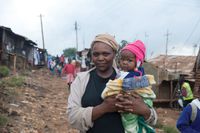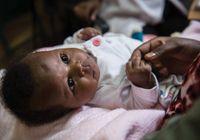
Photo credits: Save the Children/Hannah Maule-ffinch
Chapter 2: Background. The Field Guide begins with an introduction to humanitarian settings and the challenges to providing health services within them, followed by an overview of newborn epidemiology. The reader may use these facts to enhance communication and training materials for humanitarian health staff, as well as to advocate for increased attention to the topic of newborn health in crisis situations at the uppermost levels of policy and program development.
Chapter 3: Newborn Health Services. This section includes abridged clinical and technical guidance for providing essential newborn care in humanitarian settings at all three levels of care (Household/community, Primary, Hospital). It also provides additional guidance around preventing and treating the three main causes of newborn mortality. The outlined services and required commodities are relevant whether crisis-affected populations are accessing health services through UNabbreviation/NGO supported services (such as mobile or camp clinics) or via local health care systems. The reader may use this guidance while developing programmes to respond to newborn health needs as well as to understand the skills and supplies health workers need to be equipped with to provide quality and respectful newborn care.
Chapter 4: Strategic Considerations. This section presents considerations for broader program development, service integration and coordination within humanitarian settings. Areas addressed include working with humanitarian response partners at the onset of an emergency, developing partnerships with governments, development, and humanitarian partner organizations, conducting a situation analysis, developing a unified strategy and response plan for the provision of integrated quality and respectful maternal and newborn care, and introducing a monitoring and evaluation (M&E) plan that incorporates key health indicators and mortality surveillance. The reader might find this chapter useful in understanding entry points to collaborating with other actors in a humanitarian situation and broader considerations to keep in mind while developing integrated maternal and newborn health programmes.
Chapter 5: Program Implementation Considerations. This section presents guidance related to newborn health service development and implementation. Critical activities described in this section include developing key messages and BCC materials, developing referral systems, strengthening postnatal care at the community level, procuring Newborn Care Supply Kits, and providing support for neonatal loss.
Resources. Relevant resources that complement the guidance contained within the Field Guide are presented throughout the Chapters with the icon: info. Other additional resources are also included at the end of each chapter and have also been consolidated in the resources section of the website.
Annexes. A set of annexes containing practical tools and templates to facilitate newborn health interventions is included at the end of the Field Guide.

